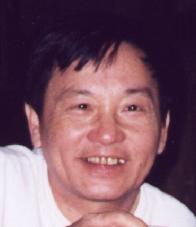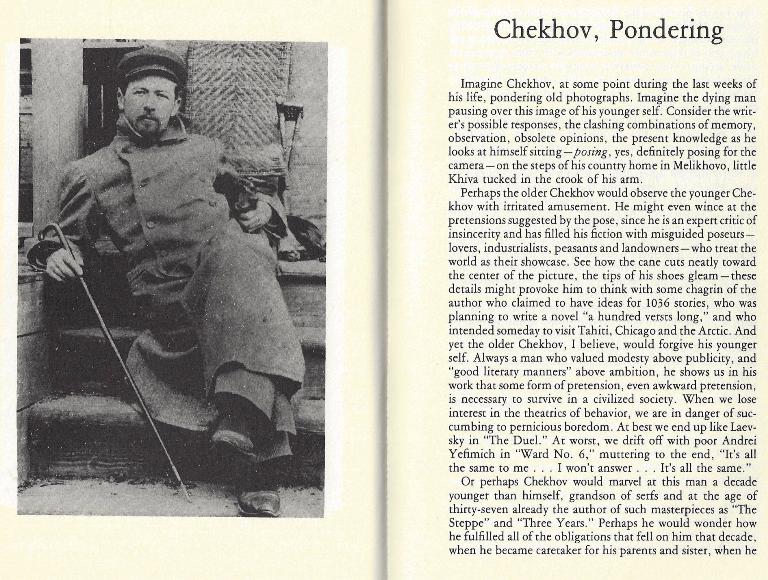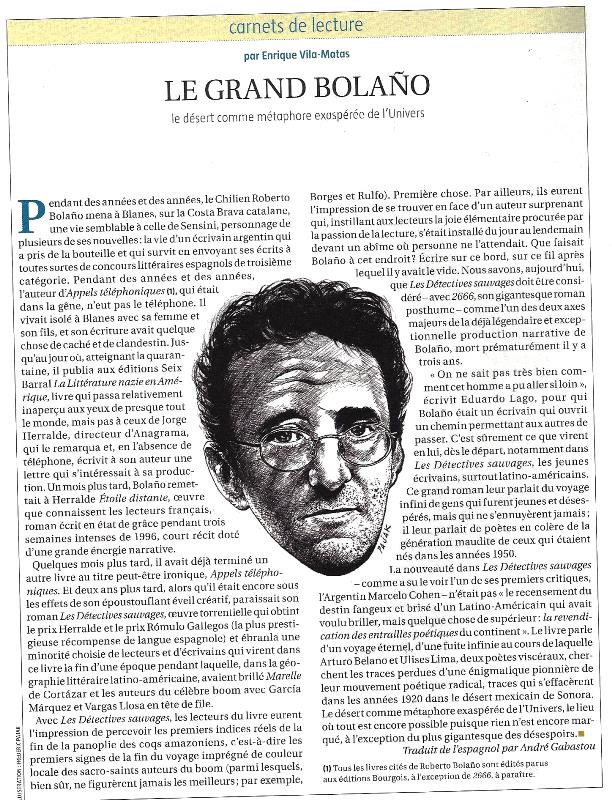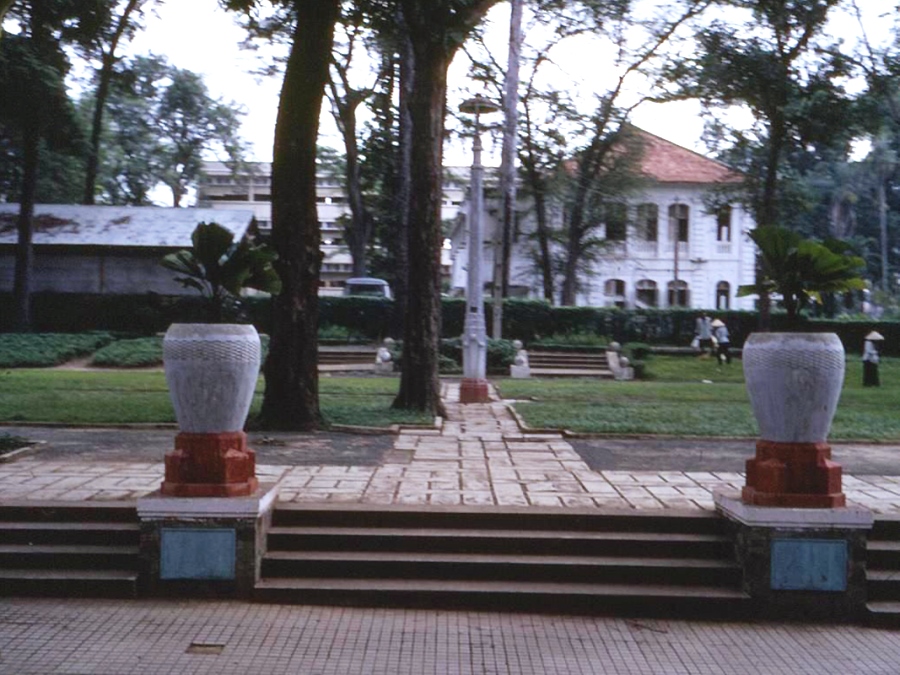Mùa
thu, những di dân

Di
dân là "số" phần, (a matter of arithmetic),
theo Kundera.
Độc và Đẹp
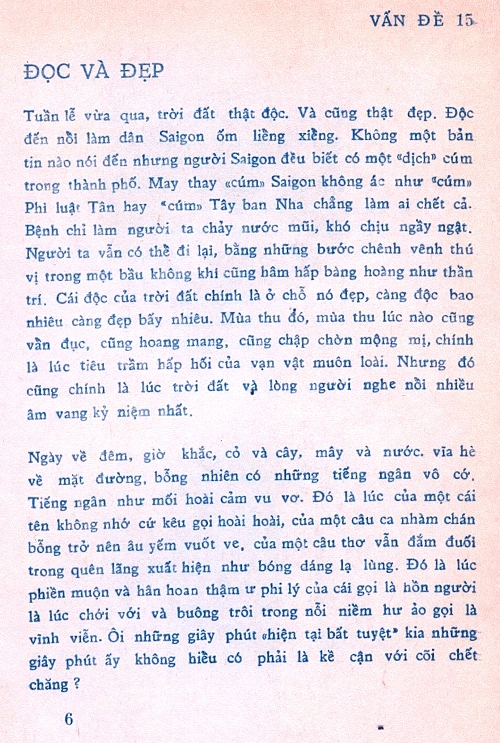
Thu 2014

L'adieu
Apollinaire (1880-1918)
J'ai cueilli ce brin de bruyère
L'automne est morte souviens-t'en
Nous ne nous verrons plus sur terre
Odeur du temps brin de bruyère
Et souviens-toi que je t'attends
Lời vĩnh biệt
(1)
Ta đã hái nhành lá cây
thạch thảo
Em nhớ cho, mùa thu đã chết rồi
Chúng ta sẽ không tao phùng được
nữa
Mộng trùng lai không có ở trên
đời
Hương thời gian mùi thạch thảo bốc hơi
Và nhớ nhé ta đợi chờ em đó ...
(2)
Ðã hái nhành kia một buổi nào
Ngậm ngùi thạch thảo chết từ bao
Thu còn sống sót đâu chăng nữa
Người sẽ xa nhau suốt điệu chào
Anh nhớ em quên và em cũng
Quên rồi khoảnh khắc rộng xuân xanh
Thời gian đất nhạt mờ năm tháng
Tuế nguyệt hoa đà nhị hoán tam
(3)
Mùa thu chiết liễu nhớ chăng em ?
Ðã chết xuân xanh suốt bóng
thềm
Ðất lạnh qui hồi thôi hết dịp
Chờ nhau trong Vĩnh Viễn Nguôi Quên
Thấp thoáng thiều quang mỏng mảnh dường
Nhành hoang thạch thảo ngậm mùi vương
Chờ nhau chín kiếp tam sinh tại
Thạch thượng khuê đầu nguyệt diểu mang
Xa nhau trùng điệp quan san
Một lần ly biệt nhuộm vàng cỏ cây
Mùi hương tuế nguyệt bên ngày
Phù du như mộng liễu dài như mơ
Nét mi sầu tỏa hai bờ
Ai về cố quận ai ngờ ai đi
Tôi hồi tưởng lại thanh kỳ
Tuổi thơ giọt nước lương thì ngủ yên
Bùi Giáng (1925-1998) dịch
(Ði vào cõi thơ, tr 80-82, Ca Dao
xuất bản, Sàigon, Việt Nam)
Nguồn net
GUILLAME APOLLINAIRE
(1880-1918)
The Farewell
I picked this fragile sprig of heather
Autumn has died long since remember
Never again shall we see one another
Odor of time sprig of heather
Remember I await our time together
Translated from the French by Roger Shattuck
[in Time of Grief]
Thơ Mỗi Ngày
HAIKU
The endless night
is now nothing more
than a scent.
Is it or isn't it
the dream I forgot
before dawn?
The sword at rest
dreams of its battles.
My dream is something else.
The man has died.
His beard doesn't know.
His nails keep growing.
Under the moon
the lengthening shadow
is all one shadow .
•
The old hand
goes on setting down lines
for oblivion.
-S.K.
J.J. Borges: Poems of the Night
Haiku
Đêm vô tận
Còn chăng,
Thì là một mùi
Cái gì gì, tàn hôn lên
môi
Tàn quên trong tay
Có, hay không
Giấc mộng Gấu quên
Trước rạng đông
Cái gì gì, đêm không sao
qua
Mà trời sao lại sáng?
Cây kiếm ngơi
Mơ hoài những trận chém giết cũ
Giấc mơ của Gấu
Là một điều gì khác
Thẳng chả ngỏm
Râu đếch biết
Móng tay dài mãi ra
Dưới ánh trăng
Cái bóng của Gấu
Dài mãi ra
Vẫn chỉ là bóng của Gấu!
Bàn tay già
Tiếp tục lần
Những dòng
Dành cho quên lãng
Borges Golem
THE GIFT
In a page of Pliny we read
that in all the world no two faces are alike.
A woman gave a blind man
the image of her face,
without a doubt unique.
She chose the photo among many;
rejected all but one and got it right.
The act had meaning for her
as it does for him.
She knew he could not see her gift
and knew it was a present.
An invisible gift is an act of magic.
To give a blind man an image
is to give something so tenuous it can be infinite
something so vague it can be the universe.
The useless hand touches
and does not recognize
the unreachable face.
J. L. Borges: Poems of the Night
Quà
tặng
Trong một trang của Pliny, chúng
ta đọc thấy điều này,
Trong cả 1 lũ người như thế đó, không làm
sao có hai khuôn mặt giống nhau y chang
Một người đàn bà cho 1 anh mù bức hình
khuôn mặt bà.
Bà chọn tấm hình trong rất nhiều;
vứt đi tất cả, chỉ giữ lại một, và chọn đúng
tấm cần chọn.
Cái hành động đó, thì thật có
nghĩa, đối với bà
Và luôn cả với người đàn ông mù.
Bà biết anh mù không thể nhìn
thấy quà tặng của bà
Và biết, đó là 1 quà tặng
Một món quà vô hình là
1 hành động huyền diệu
Cho 1 người mù một hình ảnh
Thì cũng như cho một điều gì tinh tế, giản
dị, như “cúi xuống là đất”, như Cô Tư phán.
Chính vì thế mà nó trở thành
vô cùng
Một điều gì đó mơ hồ như là vũ trụ
Bàn tay vô dụng, sờ
Và không nhận ra
Khuôn mặt không làm sao với tới được.
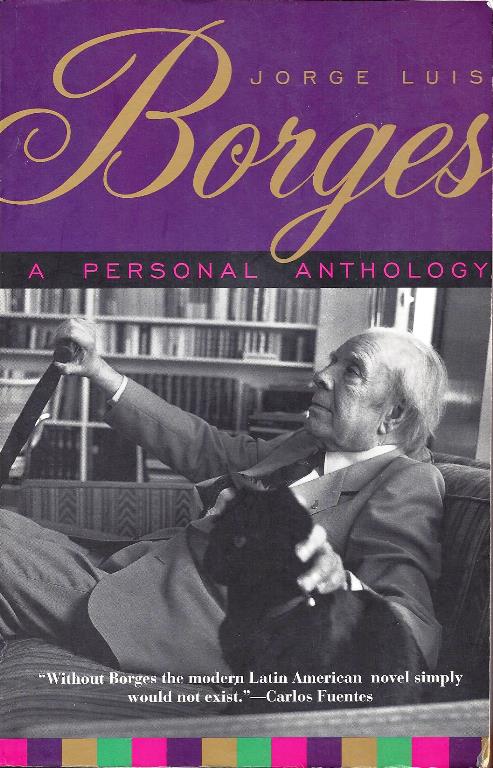
PARADISO XXXI, 108
Diodorus Siculus narrates the story of a dismembered
and sundered god, who, as he walks in the twilight or traces
a date in his past, never senses that something infinite has been
lost.
Mankind has lost a face, an
irretrievable face, and everyone would like to be that pilgrim
(dreamed of in the empyrean, under the Rose) who sees Veronica's
handkerchief in Rome and murmurs with faith: Jesus
Christ, My Lord, True God, this, then, was Your Face?
There is a stone face on a
certain road and an inscription which reads: The true Portrait
of the Holy Face of the God of Jaén, If we really knew the likeness,
we would have the key to the parables and would know if the
son of the carpenter was also the Son of God.
Paul saw it in the guise of
a light which hurled him to the ground; John, as the sun shining
in full force; Teresa of Jesus, oftentimes, as if bathed in a tranquil
light, but she was never able to specify the color of the eyes.
We lost those features, in
the way a magical number may be lost, a number made up of customary
figures; in the same way as an image in a kaleidoscope is lost
forever. We may see them, and not know it. The profile of a Jew in
the subway may be that of Christ; the hands which give us some coins
at a change-window may recall those which some soldiers once nailed to
the Cross.
Perhaps some feature of the
Crucified Face lurks in every mirror; perhaps the Face died,
was effaced, so that God might become everyone.
Who knows whether we may not
see it tonight in the labyrinths of dreams and remember nothing
tomorrow.
- Translated by ANTHONY KERRIGAN
Diodorus Siculus tells the
story of a god who had been cut into pieces and then scattered;
which of us, strolling at dusk or recollecting a day from the past,
has never felt that something of infinite importance has been lost?
Mankind has lost a face, an
irretrievable face. At one time everyone wanted to be the pilgrim
who was dreamed up in the Empyrean under the sign of the Rose,
the one who sees the Veronica in Rome and fervently mutters: "Christ
Jesus, my God, truly God: so this is what your face was like?"
There is a stone face by a
road and an inscription that reads: ''Authentic Portrait of the
Holy Face of the Christ of Jaén," If we really knew what that
face had been like, we would possess the key to the parables and
we would know whether the son of the carpenter was also the Son of God.
Paul saw it as a light that
knocked him to the ground. John saw it as the sun shining with
all its strength. Teresa of Avila often saw it bathed in a serene
light, but she could never quite make out the color of the eyes.
These features have been lost
to us the way a kaleidoscope design is lost forever, or a magic
number composed of everyday figures. We can be looking at them
and still not know them. The profile of a Jewish man in the subway
may well be the same as Christ's; the hands that make change for
us at the ticket window could be identical to the hands that soldiers
one day nailed to the cross.
Some feature of the crucified
face may lurk in every mirror. Maybe the face died and faded
away so that God could be everyman.
Who knows? We might see it tonight in the labyrinths
of sleep and remember nothing in the morning.
-K.K.
Penguin ed
Diodorus Siculus kể câu
chuyện một vị thần bị chém, chặt, xẻ thành từng mẩu
rồi quăng tứ lung tung, ai trong số chúng ta, lang thang trong
hoàng hôn, hay, lượm lặt một ngày từ quá
khứ, chẳng hề cảm nhận rằng thì là, một điều cực kỳ thiên thu bất diệt, cực kỳ quan
trọng, đã
mất?
Nhân loại mất mẹ cái bộ mặt, một bộ mặt không
làm sao thu gom, nhặt nhạnh lại được, và, mọi người,
người người, ai cũng thèm là vị hành giả kia,
mơ hoài một Thiên Cung, dưới dấu hiệu BHD, kẻ đã
từng chiêm ngưỡng cái khăn tay của Thánh Nữ, một
bữa ở… Chợ Lớn, và lẩm bẩm, với Niềm Tin: Thánh Nữ
ơi, phải chăng, đây đúng là Khuôn Mặt của Người?
Đó là khuôn mặt của một hòn
đá bên vệ đường, và một hàng chữ, Khuôn
mặt thực của Chúa Jaén. Nếu chúng ta thực sự
hiểu ra sự tương đồng, tương ứng, chúng ta sẽ có được cái
chìa khoá của ẩn ngữ, và chúng ta, biết,
đấng con trai, là con của ông thợ mộc, hay là
Con của Chúa.
Paul chứng kiến phép lạ, và nó quất
cho anh đánh rầm 1 phát xuống mặt đất. John nhìn
thấy nó, như là 1 cú mặt trời với tất cả sức mạnh
của nó. Teresa of Avila thường nhìn
thấy nó, tắm trong 1 thứ ánh sáng thanh thản,
nhưng bà không làm sao nhận ra màu của mắt.
Những cảnh tượng này, đã mất đối với chúng
ta, theo cái cách mà kính vạn hoa vĩnh
viễn mất, hay con số thần kỳ gồm những hình tượng mọi
ngày. Chúng ta có thể nhìn, nhưng đâu
thấy, chúng. Cái bóng dáng của 1 tên
Mít đang lang thang 1 ngày đẹp trời ở 1 thành phố
Canada, hay đang chờ xe điện ngầm ở 1 subway station ở Toronto, thí
dụ, biết đâu đấy, thì cũng là bóng của Christ,
và cái bàn tay đang đưa cái vé xe
điện ngầm ở quầy, biết đâu đấy, là 1 trong những bàn
tay của 1 tên VC đóng đinh Chúa.
Một cảnh sắc nào đó, của khuôn mặt
bị đóng đinh thập giá, có thể lấp ló trong
mọi tấm gương.
Có thể bộ mặt chết, và nhạt nhòa
trong mưa, theo dòng thời gian và nếu thế, Chúa
có thể là bất cứ một người, mọi người.
Who knows?
GCC có thể thấy nó, đêm nay, trong
những mê cung của giấc ngủ, và sáng mai, mải
nhớ BHD,
bèn quên mẹ
nó mất!
Legend
Cain and Abel came upon each other after Abel's death.
They were through the desert, and they recognized each other from
afar, since men were very tall. The two brothers sat on the ground,
made a fire, and ate. They sat silently, as weary people do when dusk
begins to fall. In the sky, a star glimmered, though it had not yet been
given a name. In the light of fire, Cain saw that Abel's forehead bore
the mark of the stone, and dropped the bread he was about to carry to
his mouth and asked his brother to forgive him. "Was it you that killed
me, or did I kill you?" Abel answered. "I don't remember anymore; here
we are, together, like before."
"Now I know that you have truly forgiven me;' Cain said,
"because forgetting is forgiving. I, too, will try to forget."
"Yes;' said Abel slowly. “So long as remorse lasts,
guilt lasts."
Penguin ed
Note: Tình cờ lướt net,
thấy đã được dịch:
http://www.tienve.org/home/activities/viewTopics.do?action=viewArtwork&artworkId=1035
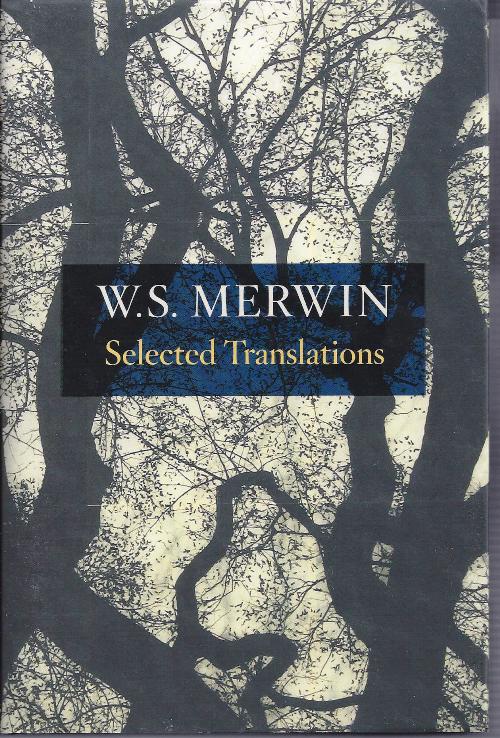
Iosip Brodsky
Russian
1940-1996
THE BLIND MUSICIANS
The blind go their way
by night.
It's
easier to cross
the
squares
at night.
The
blind live
feeling
their way,
brushing
the world with their hands,
knowing
neither shadow nor light,
and
their hands drift over the stones
built
into walls
of
men, women,
children,
money,
walls
that cannot be broken,
better
to
follow along them.
Against
them the music
hurls
itself
and
the stones soak it up.
In
them the music dies
under
the hands.
It's
hard dying at night, hard
to
die feeling your way.
The
way of the blind is
simpler,
the blind
cross the empty squares.
1967,
translated with
Wladimir
Weidlé
Cuốn sách về Brodsky này,
như lời Bạt cho thấy, có cùng tuổi [hải ngoại] của Gấu, 1997,
hay đúng hơn, kém Gấu ba tuổi.
Gấu làm quen Brodsky thời gian này, nhân
đọc Coetzee viết về những tiểu luận của ông, trên tờ NYRB;
bài tưởng niệm khi ông mất, của Tolstaya...
Trong cuốn này, có nhắc tới bài viết,
Gấu chôm, xen với những kỷ niệm về Joseph Huỳnh Văn, trong
bài “Ai cho phép mi là thi sĩ”
Post ở đây, rảnh rang lèm bèm sau.
Thú nhất câu: "Hãy nhớ Gấu, và
quên số mệnh cà chớn của Gấu"!
"Remember me, but ah! Forget my fate!"
Nghĩa địa Do Thái
ở Leningrad
Nghĩa địa" như bài thơ
được gọi, trong bài viết, thì chẳng hay ho gì,
không chỉ ở cái giọng kể lể, mà còn cả ở
cái chất thơ xuôi của nó. Khổ đầu thì còn
có vần điệu, nhưng sau biến thành thơ tự do. Ngoài
nó ra, không còn bài nào như thế,
trong số tác phẩm của Joseph... nhưng khi được 1 tay xb hỏi,
có cho nó vô 1 tuyển tập Những tiếng nói ở bên trong
[chiếc thuyền] Noé: Những nhà thơ Do Thái Hiện Đại,
do anh ta xb, hay là không [Anthony Rudolf, co-editor of
the international anthology Voices Within the Ark: The Modern
Jewish Poets (1980) tells me that when asked if he would be willing
to be included in the book], Brodsky nghiêm giọng phán, ta
"muốn" có nó, trong đó!
Hay, thí dụ, trong lần trả lời báo chí
Tháng Chạp, 1987, ở Stockholm, khi tới đó lấy cái
Nobel, “Tớ thấy tớ như 1 tên… Ngụy, dù
chưa từng biết truyền thống Ngụy nó ra làm sao”, và
nói thêm, “Về ngôn ngữ của riêng tớ, thì
đúng là của 1 tên… Mít”!
Là 1 tên Ngụy, thì giống như 1 tên
lưu vong, có tí lợi; nó đẩy tên đó
ra bên lề, thay vì ở trung tâm xã hội. Lũ
Ngụy có thói quen choàng cho chúng 1 màu
của chung lũ chúng, ở loanh quanh chúng. Lịch sử Ngụy
ban cho từng cá nhân Ngụy 1 thứ văn hóa, và
đây là nguồn sức mạnh của chúng, nhưng vưỡn không
làm sao giấu được nhược điểm, là ở bất cứ đâu, bất
cứ lúc nào, nó cảm thấy chẳng ra cái chó
gì cả, hắn đếch thuộc về ai, về đâu, đại khái thế!
The Word That Causes Death’s Defeat
Cái
từ đuổi Thần Chết chạy có cờ
Kinh Cầu đẻ ra từ một sự kiện, nỗi đau
cá nhân xé ruột xé gan, và cùng
lúc, nó lại rất là của chung của cả nước, một
cách cực kỳ ghê rợn: cái sự bắt bớ khốn kiếp của
nhà nước và cái chết đe dọa người thân thương
ruột thịt. Bởi thế mà nó có 1 kích thước vừa
rất đỗi riêng tư vừa rất ư mọi người, rất ư công chúng,
một bài thơ trữ tình và cùng lúc, sử
thi. Nó là tác phẩm của ngôi thứ nhất, thoát
ra từ kinh nghiệm, cảm nhận cá nhân. Tuy nhiên, trong
lúc chỉ là 1 cá nhân đau đớn rên rỉ
như thế, thì nó lại là độc nhất: như sử thi, bài
thơ nói lên kinh nghiệm toàn quốc gia….
Đáp ứng, của Akhmatova,
khi Nikolai Gumuilyov, chồng bà, 35 tuổi, thi sĩ, nhà
ngữ văn, trong danh sách 61 người, bị xử bắn không cần bản
án, vì tội âm mưu, phản cách mạng, cho thấy
quyết tâm của bà, vinh danh người chết và gìn
giữ hồi ức của họ giữa người sống, the determination to honor the dead,
and to preserve their memory among the living….
Trong 1 bài viết trên talawas, đại thi sĩ Kinh
Bắc biện hộ cho cái sự ông ngồi nắn nón viết tự
kiểm theo lệnh Tố Hữu, để được tha về nhà tiếp tục làm
thơ, và tìm lá diêu bông, rằng, cái
âm điệu thơ Kinh [quá] Bắc [Kít] của ông,
buồn rầu, bi thương, đủ chửi bố Cách Mạng của VC rồi.
Theo sự hiểu biết cá
nhân của Gấu, thì chỉ hai nhà thơ, sống thật đời của
mình, không 1 vết nhơ, không khi nào phải “edit”
cái phẩm hạnh của mình, là Brodsky và ông
anh nhà thơ của GCC.
Chẳng thế mà Milosz rất thèm 1 cuộc đời như
của Brodsky, hay nói như 1 người dân bình thường
Nga, tớ rất thèm có 1 cuộc đời riêng tư như của
Brodsky, như trong bài viết của Tolstaya cho thấy.
Bảnh như Osip Mandelstam mà
cũng phải sống cuộc đời kép, trong thế giới khốn nạn đó.
Để sống sót, Mandelstam cũng
đã từng phải làm thơ thổi Xì, như bà vợ
ông kể lại, và khi những người quen xúi bà,
đừng bao giờ nhắc tới nó, bà đã không làm
như vậy:
Nadezhda Mandelstam recalled
how her husband Osip Mandelstam had done what was necessary to survive:
To be sure, M. also, at the
very last moment, did what was required of him and wrote a hymn of praise
to Stalin, but the "Ode" did not achieve its purpose of saving his life.
It is possible, though, that without it I should not have survived either.
. . . By surviving I was able to save his poetry.... When we left Voronezh,
M. asked Natasha to destroy the "Ode." Many people now advise me not to speak
of it at all, as thou it had never existed. But I cannot agree to this, because
the truth would then be incomplete: leading a double life was an absolute
fact of our age and nobody was exempt. The only difference was that while
others wrote their odes in their apartments and country villas and were rewarded
for them, M wrote his with a rope around his neck. Akhmatova did the same,
as they drew-the noose tighter around the neck of her son. Who can blame
either her or M.
Roberta Reeder: Akhmatova, nhà thơ, nhà
tiên tri
Trong khi lũ nhà văn
nhà thơ Liên Xô làm thơ ca ngợi Xì và
được bổng lộc, thì M làm thơ ca ngợi Xì với cái
thòng lọng ở cổ, và bài thơ “Ode” đó cũng chẳng
cứu được mạng của ông. Người ta xúi tôi, đừng nhắc tới
nó, nhưng tôi nghĩ không được, vì như thế sự thực
không đầy đủ: sống cuộc đời kép là sự thực tuyệt đối
của thời chúng ta.
Tuyệt.
Chỉ có hai nhà
thơ sống sự thực tuyệt đối của thời chúng ta, bằng cuộc đời
“đơn” của họ, là Brodsky và TTT!
Etkind relates how this trial
pitted two traditional foes against each other, the bureaucracy and
the intelligentsia. Brodsky represented Russian poetry.
Viết Mỗi Ngày
Cách
Mạng Vô Sản của Lê Nin
The Russian revolution
Missed connection
Vladimir Lenin’s railway journey from Switzerland to Russia changed history
http://www.tanvien.net/TG2/tg2_ve_van_lichsu.html
Chekhov, Pondering
Imagine Chekhov, at some point
during the last weeks of his life, pondering old photographs. Imagine
the dying man pausing over this image of his younger self. Consider
the writer's possible responses, the clashing combinations of memory,
observation, obsolete opinions, the present knowledge as he looks
at himself sitting -posing, yes, definitely posing for the camera-on
the steps of his country home in Melikhovo, little Khiva tucked in
the crook of his arm. Perhaps the older Chekhov would observe the younger
Chekhov with irritated amusement. He might even wince at the pretensions
suggested by the pose, since he is an expert critic of insincerity
and has filled his fiction with misguided poseurs- lovers, industrialists,
peasants and landowners-who treat the world as their showcase. See
how the cane cuts neatly toward the center of the picture, the tips
of his shoes gleam-these details might provoke him to think with some
chagrin of the author who claimed to have ideas for 1036 stories, who
was planning to write a novel "a hundred versts long," and who intended
someday to visit Tahiti, Chicago and the Arctic. And yet the older Chekhov,
I believe, would forgive his younger self. Always a man who valued modesty
above publicity, and "good literary manners" above ambition, he shows
us in his work that some form of pretension, even awkward pretension,
is necessary to survive in a civilized society. When we lose interest
in the theatrics of behavior, we are in danger of succumbing to pernicious
boredom. At best we end up like Laevsky in "The Duel." At worst, we
drift off with poor Andrei Yefimich in "Ward No.6," muttering to the end,
"It's all the same to me ... I won't answer ... It's all the same." Or
perhaps Chekhov would marvel at this man a decade younger than himself,
grandson of serfs and at the age of thirty-seven already the author
of such masterpieces as "The Steppe" and "Three Years." Perhaps he would
wonder how he fulfilled all of the obligations that fell on him that
decade, when he became caretaker for his parents and sister, when he
served as the doctor for the local peasants and as squire of the village
of Melikhovo and still managed to make the grueling trip across Siberia
to the island of Sakhalin. He might recall his pattern of responsible
moderation with more than a little pride, seeing in this portrait a man
who devoted himself to the problems of others and yet could come close
himself in his study for hours at a time, pick up his pen and hear the grass
singing in his mind. It could be, though, that the dying Chekhov would neither
wince nor marvel at this picture but turn away in despair, comprehending
more fully than ever before his own dishonesty. Here is Dr. Chekhov, villain
of self-deception. What did it matter that he suffered his first bout of
blood-spitting in 1884, shortly after graduating from medical school? What
did it matter that for thirteen years, though he treated many victims of
tuberculosis, he refused to identify the symptoms in himself? The disease
probably would have progressed at the same speed even had he sought treatment
earlier. But the lack of acknowledgement is troubling. If he'd been one
of his characters, his pose of health would have revealed itself as a lie,
and he would have seemed pathetic in his stubborn effort to make a lasting
name for himself. Of course, this Chekhov, the Chekhov lounging on the
steps of his Melikhovo home, collar turned up just so, will be remembered:
as the jaunty, brilliant writer, as the modest poseur and as a dying man
unable to acknowledge his illness because the telling would have made death
sensible. He preferred to tell of life.
-Joanna Scott
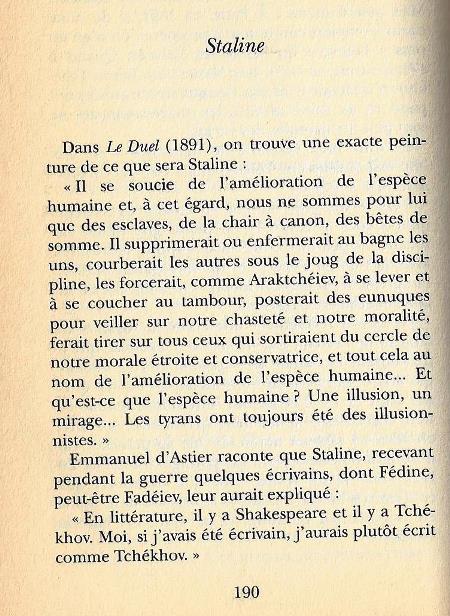
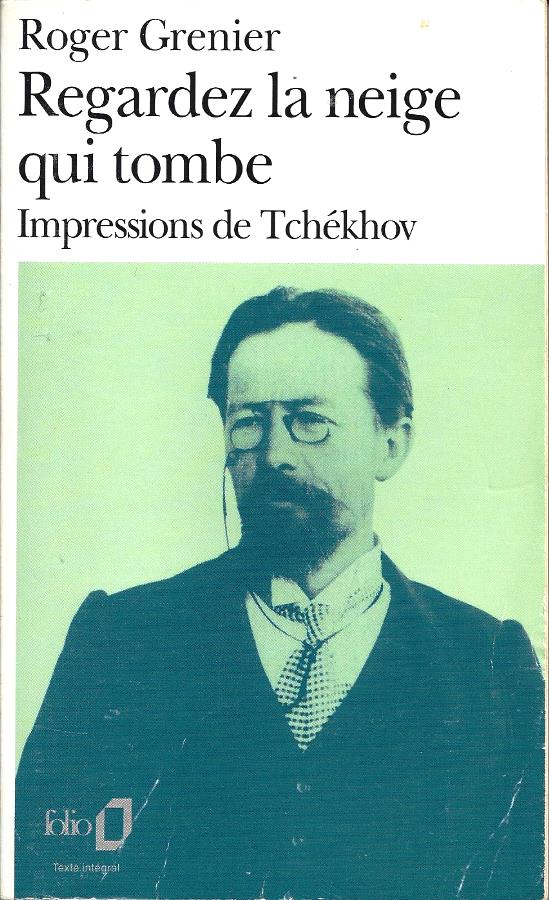
Trong Duel,
người ta nhận ra, đúng là chân dung Xì
sau này. Người quan tâm đến chuyện trồng người,
cải thiện nó, và dưới mắt người, cái giống người
như là hiện nay, thì là những tên nô
lệ, những con vật......
Trong 1 lần gặp gỡ những nhà văn, Xì
phán, trong văn chương, có Shakespeare, và
Chekhov. Tớ, nếu là nhà văn, chỉ mong viết được như Chekhov!
La petitesse de l'homme chez Anton Tchekhov
De Tchekhov et sur Tchekhov,
cette année (1), date du cinquantenaire de sa mort (1er juillet
1904), nous avons eu la possibilité de lire différentes
choses, et chaque fois, au cours de ces lectures, nous n'arrêtions
pas de nous demander: mais en quoi consiste vraiment le secret de
cet homme? Quel est le secret qui le rend d'autant plus cher et grand
et toujours actuel qu'il joue en «mineur », en décrivant
une réalité limitée, quel est le secret qui
le fait apprécier des lettrés les plus raffinés
comme du grand public des quotidiens du soir (qui, aujourd'hui encore,
lorsqu'ils veulent publier une nouvelle dont le succès sera certain,
puisent à sa source)? Il existe pour lui, en Union soviétique,
une affection qui touche à la vénération: et, de
ce petit médecin au regard étincelant et ironique derrière
son pince-nez, ils font presque un prophète de la sociéte
socialiste; alors qu'en Occident il est célèbre tantôt
comme un père du pessimisme et de l'agnosticisme libéraux,
tantôt même comme un symboliste mystique. Et tout cela,
il faut bien le souligner, sans que de son côté il ait
jamais fait preuve de lègereté ou de flatterie; en restant
toujours, au contraire, obstinément fidèle à
lui-même, sans pitié dans ce qu'il avait à dire,
en avancant sur un chemin sans détour, droit et linéaire.
Cet amour, parfois très fort, que l'on peut éprouver pour
lui, comme pour un frère péniblement retrouvé, avec
lequel on va pouvoir enfin tout expliquer de soi-même et tout comprendre
de lui, comment se justifie-t-il, s'il est par ailleurs le frère
de tant de gens, qui peuvent m'être sympathiques ou antipathiques,
amis ou ennemis?
Mon amour pour Tchekhov, je l'avoue,
a souvent été tourmenté par la jalousie.
Nous qui ne lisons pas le russe
et qui essayons de scruter la parole d'écrivains qui nous
sont chers à travers les traductions de même que l'on
devine les couleurs d'un visage à partir des ombres grises et
noires d 'une photographie, nous avons eu enfin cette année,
après tant de bonnes versions mais sans ordre et partielles, une
édition complète et ordonnée chronologiquement
de ses contes. «Édition complète », cela ne
veut pas dire qu'elle comprend tous les récits de Tchekhov: en effet,
il en a écrit plus de six cents, pendant les vingt et quelques années
qui vont de ses débuts dans la nouvelle dans La Cigale, un journal
humoristique banal, jusqu'aux longs récits des dernières
années, où il luttait contre la maladie qui l'emporta à
l'âge de quarante-quatre ans. Dans cette édition, il y a
les deux cent quarante morceaux qu'il a choisis en 1899 pour l'édition
définitive de ses oeuvres, en même temps que quatre-vingts
morceaux environ qu'il avait écartés, Ainsi pouvons-nous
suivre, année par année, les étapes d'un curriculum
littéraire si court et, repétons-le, si linéaire qu'on
a l' habitude de le considérer, dans l'ensemble, comme une totalité
homogène. Pour nous aider à retracer le chemin de son développement,
sont sorties cette année quelques biographies nouvelles dans des
langues occidentales : et je veux rappeler non pas tant un gros volume
paru en Angleterre (David Magarshack, Chekhov, Faber and Faber) que, plutôt,
un petit volume francais (Elsa Triolet, L' Histoire d' Anton
Tchekhov, Les Éditeurs francais réunis) qui offre
un raccourci efficace et essentiel de la vie et de l'oeuvre, de son époque,
des discussions et des problèmes d'alors, et qui focalise surtout
l'attention sur les aspects de sa figure qu'il nous intéresse
le plus d'éclaircir aujourd'hui.
Déjà, dans ses petites
nouvelles humoristiques, Tchekhov part avec une agressivite polémique
cruelle, baignant uniquement dans les faits (Le Gros et le Maigre,
Cameleon, Le Huitres, Le Sous-Officier Latrique) comme un Gogol qui
n' pas eu besoin d'une caricature déformante pour trouver ses
effets, mais les découvre sous ses yeux tels quels, prêts
à être esquissés d 'une annotation rapide, à
être racontés simplement, à voix basse. Mais si
Gogol trouvait de l’intérêt à dévoiler le
visage absurde, démoniaque, comiquement poignant qui se cachait
sous la réalité bureaucratique la plus quotidienne de la
Russie, Tchekhov, qui commence à écrire trente ans après
la mort de Gogol, veut fouiller différemment la réalité,
Dans la nouvelle La Fille d' Albion, qui date de
1885, nous trouvons déjà Tchekhov à son plus haut
degré, et le métal dont il forge ses contrastes comiques
ou dramatiques : la dignité de l'homme. Dans des nouvelles comme
celle-ci, ou comme La Choriste (1886), plus il fouaille ses petits humains,
plus il en découvre les égoismes, les faussetés
et les mesquineries sous le masque de leur fausse «dignité»,
plus se révèle à nous quelque chose qui résiste
à la dégradation, quelque chose de supérieur à
la bassesse générale, une qualité impalpable
que nous devons recommencer à appeler dignité humaine,
une dignité tout à fait opposée à celle,
hypocrite et formelle, des moeurs bourgeoises. Mais Tchekhov atteint
ses meilleurs résultats lorsque la decouverte de la fausse
dignité et les retrouvailles avec la vraie ont lieu chez le même
personnage ; lorsque le couteau qui ouvre l' abcès touche la
chair vive. Et l' on voit apparaitre alors la «pitié»
de Tchekhov, toujours d'autant plus présente qu'il est «sans
pitié » : voilà que, après avoir découvert
sous le personnage le petit-bourgeois - sa mesquinerie et son horreur
historique -, sous le petit-bourgeois, il découvre l 'homme.
Avec La Steppe (1888), événement
capital dans l'histoire de la narration moderne, Tchekhov commence
à avoir une conscience plus précise de l'importance
littéraire de son travail, et aussi de sa responsabilité
de citoyen. La critique braque son regard sur lui, et on lui reproche,
à droite comme à gauche, le fait de «ne pas prendre
parti ». Mais Tchekhov, dans ce qu'il écrivait, avait
toujours pris un parti, même s'il ne correspondait à aucun
des partis qui évoluaient dans le monde intellectuel de la bourgeoisie
russe d' alors. Au contraire, il en révelait les limites et
les échecs : dans les longs récits qui vont du Jour de
Fête (1888) jusqu'à La Fiancée (1904), ce n' est qu
'une galerie dintellectuels velléitaires et décus, de
vies de province consumées dans la paresse, de mariages et d'amours
gâchés, de femmes toujours plus vitales, ou plus justes,
ou moins coupables que les hommes. Et au centre de ces histoires il y a
presque toujours un «que faire?» politique et social, non
pas avec la ferveur qui avait été celle de Tchernichevski
et que l' on retrouvera chez Lénine, mais avec l'incertitude de
la période de réaction et de reflux révolutionnaire
du règne d' Alexandre III et des premières années
de Nicolas II, avec un manque de perspectives historiques que l'écrivain
voit se refléchir dans les vies privées, dans les habitudes,
dans les sentiments.
Plus on avance dans la lecture de Tchekhov,
plus on rencontre de personnages qui, à la fin, décident
de «travailler sérieusement » ou qui parlent
de la vie merveilleuse qu'il y aura« sur la terre dans cent,
deux cents ans », ou de la« belle bourrasque qui balaiera
tout» : deux phrases qui ont aujourd'hui un sens prophétique
suggestif, mais qui sont toujours indéterminées,
qui n'évoquent pas d'images concrètes et précises
comme nous avons l'habitude d'en trouver chez lui. Ce n'est que leur
accent de sincérite, presque de document d'un état d'âme
de l'époque, qui fait qu'elles ne nous paraissent jamais rhétoriques
; mais la mort de Tchekhov, à la veille de la première révolution
russe de 1905, acquiert presque une signification symbolique: il est
l'écrivain d'une humanité qui cherche sa voie.
En ce sens, Salle 6 (1892)
se détache de tous les autres longs récits non seulement
parce que c'est l'acte d'accusation le plus terrible et géneral
que Tchekhov ait jamais écrit (le jeune Lénine en fut
fasciné et bouleversé), mais parce qu'il investit un
moment de crise de la pensée scientifique et humanitaire bourgeoise,
la tentation de penser que tout est inutile, que le mal est invincible,
que la matière doit être considérée vanité,
et la douleur illusion. Si quelques tentations spiritualistes peuvent
avoir touché l'auteur du Pari ou du Moine noir, elles trouvent
ici un démenti, résultat d'une décision en même
temps douloureuse et féroce.
Tchekhov, le médecin éducateur
à l'ombre de la culture positiviste, et qui avait saisi
ce qu'il y avait en elle d'élan humanitaire et progressiste,
en cerne aussi, avec une sensibilité précise, les crises
et les deviations. Dans Le Duel, il nous a donné,
en 1891, un portrait parfait de nazi, un naturaliste qui soutient
la suppression des plus faibles de la part des plus forts, un portrait
où il n'y a rien à changer, ni le type physique, ni les
discours, ni le nom allemand, ni l'idéologie pseudo-scientifique,
pour retrouver en face de nous un de ceux qui, cinquante ans plus tard,
vont torturer l'Europe. Et dans ce personnage (comme dans celui de Dans
le domaine, qui est a peu près son pendant) Tchekhov n'a pas
manqué de laisser entrevoir que lui aussi n'est qu'un pauvre
homme qui pourrait être capable de bonnes actions, mais qui
n'en est pas pour autant moins féroce et inhumain. II ne s'agit
pas de superficialité sentimentale chez Tchekhov, ni d'un «Aimons-nous
les uns les autres » de la sceptique indulgence amorale qui a
tant de racines dans les moeurs italiennes; c'est la douleur sévère
pour tout ce que l'homme gaspille de lui-même, pour ce qu'il
pourrait être et qu'il n'est pas. Tchekhov a compris cela surtout
de cette société qui est encore la société
dans laquelle nous vivons: que de choses irrécupérables
sont quotidiennement perdues, que de beauté, que d'amour, que
de qualités qui pouvaient être tournées vers le
bien, que de vies gaspillées, consumées vainement. Et
en cela il n'est ni élégiaque, ni résigné
: il s'en prend à nous, il est d'une sévérité
féroce, C'est la sa morale, la “porte étroite” qu'il
ouvre à ses personnages et à nous. C'est pour cela qu'il
demeure, d'autant plus qu'il est clair et sans facons, un écrivain
« difficile », «peu commode» : parce qu'il est
plus facile de l'éviter et de broder autour de lui que de l'accepter
tel qu'il est.
Italo: Pourquoi lire les classiques
La petitesse de l' homme chez Anton
Tchekhov
Cõi người bé tí
ở Chekhov
Mon amour pour Tchekhov,
je l'avoue, a souvent été tourmenté par la
jalousie: Cái tình yêu của tôi với Chekhov,
có cái sự ghen tuông, đố kỵ ở trỏng.
Dans Le
Duel, il nous a donné, en 1891, un portrait parfait de
nazi, un naturaliste qui soutient la suppression des plus faibles
de la part des plus forts, un portrait où il n'y a rien à
changer, ni le type physique, ni les discours, ni le nom allemand,
ni l'idéologie pseudo-scientifique, pour retrouver en face
de nous un de ceux qui, cinquante ans plus tard, vont torturer l'Europe.
Trong Le Duel, ông ta đã cho chúng
ta chân dung tuyệt hảo của Nazi...
Il existe pour lui, en Union soviétique,
une affection qui touche à la vénération: et,
de ce petit médecin au regard étincelant et ironique
derrière son pince-nez, ils font presque un prophète
de la sociéte socialiste; alors qu'en Occident il est célèbre
tantôt comme un père du pessimisme et de l'agnosticisme
libéraux, tantôt même comme un symboliste mystique.
Ở Liên Xô, ông được coi như nhà
tiên tri của XHCN, ở Tây Phương, ông nổi tiếng,
khi thì như là người cha của chủ nghĩa bi quan, khi
thì như 1 biểu tượng thần bí..
Ai Điếu Roberto Bolaño,
người sáng tạo ra chủ nghĩa 'infrarealism'
Roberto Bolaño, who has died
at Blanes in northern Spain of liver failure, aged 50, was one
of the most talented and surprising of a new generation of Latin American
writers.
Born in the Chilean capital of Santiago, Bolaño
was typical of a generation of Latin American writers who had
to cope with exile and a difficult relationship with their home country,
its values and its ways of seeking accommodation with a turbulent history.
Bolaño turned to literature to express these experiences, mixing
autobiography, a profound knowledge of literature, and a wicked
sense of humour in several novels and books of short stories that
won him admirers throughout Latin America and Spain.
Bolaño spent much of his adolescence with
his parents in Mexico. He returned to Chile in 1972, to take part
in President Allende's attempts to bringing revolutionary change
to the country. Arrested for a week after the September 1973 Pinochet
coup, Bolaño eventually made his way once more to Mexico,
where he embarked on his literary career. At first he wrote poetry,
strongly marked by Chilean surrealism and experimentalism, but after
moving to Spain in 1977 he turned to prose, first in short-story
form and then more ambitious novels.
His mischievous spirit upset many fellow writers,
who often bore the brunt of his attacks. Fed up with the pious
sentimentalism of the kind of socially committed literature he
felt was expected of Chilean writers, he aimed to subvert good taste,
revolutionary or conservative. This iconoclasm led to books such
as the History Of Nazi Literature In Latin America, an invented genealogy
of writers.
In 1998, Bolaño published his best-known
work, the sprawling novel Los Detectives Salvajes (The Wild
Detectives), a challenging mixture of thriller, philosophical and
literary reflections, pastiche and autobiography, which he baptised
"infrarealism". The novel won him the Herralde and Romulo Gallegos
prizes, and established Bolaño as one of the foremost writers
in the Hispanic world.
English readers so far have only been able to
read By Night In Chile, published by Harvill this year. This is
the most straightforward of his books, looking back as it does to
the Pinochet days in Chile and the coexistence of evil, compromise
and literature in extreme situations.
When Bolaño came to London early this year
for the English publication of By Night in Chile, he was already
very ill from a longstanding liver complaint. Despite this, he
was still talking non-stop of the many projects he was involved
in, including a mammoth novel provisionally entitled 2666, already
more than 1,000 pages long, that dealt with the murders of more than
300 young women in the Mexican border town of Ciudad Juarez, another
novel, and a new collection of poetry.
But what most delighted him during his London
visit was the fact that he was already becoming better known
in Spain as a fictional character than as his "real" self. This
is because he is one of the main characters in the Spanish bestseller
by Javier Cercas, The Soldiers Of Salamis, where "Roberto Bolaño"
helps the author to successfully complete his novel.
This mingling of reality and fiction seemed to
Bolaño a confirmation that life and literature are of
equal importance. As he said at the time, "You never finish reading,
even if you finish all your books, just as you never finish living,
even though death is certain."
Bolaño had faced this certainty for years,
as his liver deteriorated. He died in hospital while awaiting
a liver transplant, and is survived by his wife Carolina and two
children, Alexandra and Lautaro.
· Roberto Bolaño, writer, born April
28 1953; died July 15 2003.
MADELEINE THIEN
Dream of the Red Chamber
My mother's favorite book was
the Chinese classic novel Dream of the Red Chamber, also known
as The Story of the Stone, also known as A Dream of Red Mansions.
This was the only work of fiction on her bookshelf. I remember picking
the novel up only once when I was young. I was drawn to its magisterial
heft, to the consolidated weight of more than a thousand pages. But
because I could not read Chinese, I gravitated instead to her Chinese-English
dictionary, a heavy yet small book, the size of my hand that translated
shapes into words (book). My mother passed away suddenly in 2002,
and her copy of Dream of the Red Chamber vanished.
The novel was written 250 years
ago by Cao Xueqin, who was still writing it when he died suddenly
in 1763. Approximately twelve copies of Dream of the Red Chamber
existed in the years following his death, handwritten editions made
by his family and friends. The manuscripts differed in small ways from
one another, but each was eighty chapters long. Unfinished, the novel
ended almost in mid-sentence.
Those handwritten copies began
to circulate in Beijing. Rumors spread of an epic, soul-splitting
tale, a novel populated by more than three hundred characters from
all walks of life, a story about the end of an era, about the overlapping
lines of illusion and existence, a novel that took hold and would
not let you go. In 1792, nearly thirty years after Cao Xueqin's death,
two Chinese scholars came forward and claimed to be in possession of
the author's papers. They proceeded to publish what they said was the
complete manuscript, consisting of one hundred and twenty chapters,
thirteen hundred pages. Movable type had existed in China since the eleventh
century, but this was the first time Dream of the Red Chamber appeared
in print.
It has been the pre-eminent
Chinese novel ever since, attracting legions of scholars-so many
that they form a movement, Redology. Some believe that, for reasons
unknown, Cao Xueqin destroyed the last forty chapters of his novel,
that the two scholars finished the book themselves. Today in China
there are more than seventy-five editions. Some are eighty chapters,
others are one hundred and twenty, and some are one hundred and ten.
Dream if the Red Chamber has multiple endings and it also has no ending.
A few years ago, I began writing
a novel set in Shanghai. My own novel circles around a hand-copied
manuscript with no author, a story with no beginning and no end.
I knew nothing about the story surrounding Dream of the Red Chamber
because I had never read the novel; no one had mentioned it in any literature
course I had ever taken. A couple of years ago, missing my mother,
I finally began to read it. The novel took root in me. When I learned
of the handwritten copies, the continuation, the unknown authorship,
I felt oddly, exhilaratingly, as if I had always known this story.
I had folded it into my own book: a truth unwittingly carried in a fiction,
an illusion as the structure of a truth.
Dream of the Red Chamber is
hands down the most widely read book in the Chinese-speaking world,
making it perhaps the most read novel in history. Professor John Minford,
who translated an edition with celebrated translator and Chinese scholar
David Hawkes, described it as a novel that combines the highest qualities
of Jane Austen, William Thackeray, Marcel Proust, and Honore de Balzac.
After 250 years, readers continue to decode its mysteries. Readers
like my mother felt ownership over the novel. With Dream of the Red
Chamber, none of us can ever know where the ending lies or what only
another beginning is. The novel itself is a playful and profound mirror
to the life of the imagination. Lines from the first chapter read, "Truth
becomes fiction when the fiction's true. Real becomes not-real where
the unreal's real. "
I still have my mother's dictionary.
I often wonder what happened to her copy if Dream of the Red
Chamber. I wonder whether it had eighty chapters, one hundred
and twenty, or one hundred and ten. It was her girlhood copy. She'd
had it through all her migrations, carrying it across the seas from
Hong Kong to Canada. I had wanted to keep it all my life, but while
I grieved my mother's sudden death, someone reached out for the book
on the shelf. They lost themselves in its love triangles, its forgotten
era, its intricate dance between this world and its dream. They carried
the book away with them, into its next life.
The Adventures of Tintin
PICO IYER
By the time I was five, I was used
to my impenitently spirited father bringing strange things into our lives.
I could perch on the stool he'd acquired made out of an elephant's foot,
spying on the robed Tibetan monks who came to him for tutoring in Plato and
Spinoza. I could stare at the photo he'd brought back of the Dalai Lama,
four years old, already seated on the Lion Throne in Lhasa (a present the
Tibetan leader had sent me, through my dad, following their first meeting,
in 1960). After three months away in West Africa teaching political theory,
suddenly my old man was dancing to highlife music in our little flat on Oxford's
Winchester Road, cheerfully oblivious of the duffle-coated, tow-headed professors'
children just outside, heading down the street to the Dragon School or its
prequel, the Squirrel.
As a child, of course, I took
this to be quite normal; the old Englishwoman we went to see in
the evenings used to magick elaborate horoscopes, all circles and
esoteric scribbles, from the thick ephemerides on her shelves. The
tall, no-nonsense the memsahib who looked after her-her daughter
and the very picture of a commander of the British Empire-had (I learned
much later) spent time as a Buddhist nun in Thailand. That handsome
colleague of my father 1 saw at Christmas parties at St. Antony's turned
out to be the legendary photographer of Tibet in the 1930s, Fosco
Maraini, who had cut off his own finger during the war to shame his
Japanese captors.
One day-my parents had, quite
fittingly, moved to California by now, though 1 continued going
to school in Oxford-I headed down a narrow, barely
lit staircase in the home of the former Buddhist nun, now my unofficial
godmother. Waiting for me at the bottom was a sparky boy journalist
in an over-coat, who'd been pierced by a vision of a stricken Chinese
friend in the snow and left Europe for the Himalayas. Within seconds,
I was following this cub reporter to the Caucasus and then through
the forests of Yugoslavia, all sinister black limousines and grimacing
operatives. I thought nothing of accompanying him into the richly colored
bazaars of the Andes, through rickshaw-filled streets in a red-lanterned
Shanghai, even to the moon. I would never have guessed then that a
journalist, who seemed to file no stories, had no apparent bosses or
office, never thought about deadlines, and simply followed adventure
wherever it took him would one day be a description of me.
Oxford in those days was a
network of children's possibilities, if you knew where to look.
A few hundred yards from my bedroom was the pub where C. S. Lewis
and J. R. R. Tolkien exchanged stories of Narnia and Middle Earth.
Up the street a little was the garden in which the Mad Hatter and
the Cheshire Cat leapt into life. Toad of Toad Hall was just around
the bend, along a drowsy river, and my hero and designated alter ego-another
foreigner appearing in England in almost the same year as I did, Paddington
Bear-inhabited a world that seemed indistinguishable from the cozy
rituals that kept us happily in place in North Oxford.
But Tintin was the one to fling
open a lifestyle for me, if only because he seemed so unrooted
and so restless. We never saw his home; we could never associate
him with a family. All he had was a movable feast of lovably unpredictable
friends, a loyal four-legged companion, and a blend of curiosity
and conscience that seemed to land him always in rapturously unexpected
settings that his creator, Hergé, had fashioned out of constant
trips to museums and through books.
The stories were unexceptional.
The characters were one-dimensional. I can't say my imagination
was deepened or stretched by the books, as it would be by, say,
Ursula Le Guin's ageless and profound Earthsea novels. Yet the beauty
of Tintin was that the background was the point,
at least for me. It was never the protagonist, the dialogue, the plot
that mattered; what it gave this small reader was a hunger to be out
in the world, in the midst of bustling markets and unreadable strangers,
of words lost in translation and levitating monks, where everything
we once thought strange would come in time to be familiar.
Paddington Bear gave me a template
out of which to form a character; but it was Tintin who threw
open the doors to an entire destiny. +
On childhood Books
Brick, A Literary Journal, n# 95, Summer 2015
Six
Poets Hardy to Larkin
The Moon
TTT 10
năm
SN_GCC_2016
Viết Mỗi Ngày
This prolific
novelist is little known to English-language readers. A new series of
translations will introduce them to his sinister work
Trùm tiểu thuyết đen của Tẩy.
Như Simenon, cả hai đếch thèm chơi với giới văn nhân,
và chẳng hề được coi là trí thức Tẩy
Dard, like
Simenon, relished his status as a best-selling provincial outsider. “Neither
of them had much connection with the literary world,” Bellos explains,
“and neither could be considered a ‘French intellectual’: both left school
at 15.” However, as much as his great counterpart, Dard roots slaughter
and mayhem in the implacable collision of desire and destiny. That deadly
machine can feel as classically French as a play by Racine or a novel
by Balzac.
Both protagonist and victim, Albert cannot escape his fate, and
nor does he wish to. Dard, notes Bellos, “had a view of humanity almost
as unflattering as Simenon’s”. In a spasm of compassion, Albert gives
a Christmas-tree decoration to Lucienne: a velvet bird in a silver cardboard
cage. That present will help to damn him. The cage-door swings shut, and
he locks himself inside.
Bird
in a Cage by Frédéric Dard, translated by David
Bellos (Pushkin Vertigo)
Ui chao,
lại nhớ thời mới nhớn, mê Simenon như điên. Lúc nào
cũng thủ 1 cuốn Simenon trong túi. Mỗi lần được phái đi
sửa máy tại 1 đài Bưu Điện địa phương, là phải có
Simenon cùng đi. Gấu khá tiếng Tẩy là nhờ tiểu thuyết
đen Tẩy
Opened in
1997, the world’s only phallological museum has been growing ever since.
This year the exhibition will attract 50,000 visitors
Mit Critic
Một ý
nghĩ:
Đối với
nhà văn đích thực, ngày mai phải viết hay hơn hôm
qua, đó không chỉ là một đòi hỏi mang tính
thẩm mỹ mà còn là, thậm chí trước hết là,
một đòi hỏi mang tính đạo lý - cũng bức thiết và
tự nhiên giống như ngày mai phải sống đẹp hơn hôm
qua.
Tuy nhiên, mặt khác,
nếu bạn không làm được như vậy, thì ít nhất
bạn hãy bao dung với mình nếu biết bạn đã cố hết sức.
... See More
Đấng này,
Gấu đọc, ngay từ khi vừa xuất hiện trên diễn đàn VHNT trên
lưới, của PCL, và thú thực, không có ý
kiến.
Khác hẳn trường hợp Nguyễn Quang Lập, cũng xuất hiện, cũng
trên VHNT, đọc 1 phát là trúng đòn
liền, và là cái mẩu Cục Uất của anh ta.
Bọ Lập sau đó, nổi như cồn, với loạt bài, trên
TV có post lại. Nhưng sau đó, là hết. Gấu đã
từng dùng hình ảnh ánh lửa ma trơi, để diễn tả trường
hợp của anh ta.
Nhưng vấn đề của TTCD, khác hẳn.
Thì nói toạc ra ở đây, anh ta viết hoài
thì cũng vẫn mãi như thế.
Và quả nó liên quan đến mỹ, đến đạo lý,
nhưng không phải
như anh ta hiểu.
Trường hợp của TTCD, là trường hợp của… GCC, thời
mới lớn, và Sartre diễn tả thật là thần sầu. Nhớ, Gấu, thú
thực, đọc 1 phát, lại 1 phát, là thấm cả 1 đời.
Sartre phán: Vảo mỗi thời đại, con người nhận ra mình,
lọc ra mình, khi đối diện với tha nhân, tình yêu
và cái chết
A chaque époque, l'homme se choisit en face d'autrui, de
l'amour et de la mort.
Theo GCC, TTCD, như cả 1 thời của anh ta, khôn quá,
hoặc nhát quá, chẳng chọn gì!
Anh ta không dám lọc mình ra, giữa cả 1 thời của anh ta! (1)
(1)
http://www.tanvien.net/tap_ghi_7/chuoi_5.html
Tại sao
mày cứ viết về mấy chuyện "chính trị", nhắc đến tụi chúng
nó làm gì vậy? Chúng nó đâu
có đáng để cho mày viết?
Một ông nhà văn Miền Nam, cũng bạn văn của Hai Lúa
ngày nào, tỏ ra bực mình.
Nhưng Hai Lúa đâu có viết về chúng
nó, mà viết về những người mà chúng nó
ngồi lên đầu!
http://www.tanvien.net/gioithieu_02/cuc_uat.html
Ui chao, Sartre, Camus và
thời mới lớn của Gấu, và những câu thần chú.
Con người bị kết án phải tự do. L’homme est condamné
à être libre.
Địa ngục là tha nhân. L’enfer, c’est les autres.
Kỹ thuật tiểu thuyết luôn qui chiếu về siêu hình
học của tiểu thuyết gia, une technique romanesque renvoie toujours à
la métaphisique du romancier. Sartre đọc Âm Thanh và
Cuồng Nộ của Faulkner. Câu phán này quả là quá
khủng khiếp, vì nó trở thành kim chỉ nam đối với cái
việc điểm 1 cuốn sách. Sartre đọc Faulkner, và khám
phá 1 siêu hình học về thời gian: Trong Âm Thanh
và Cuồng Nộ, Faulkner đập nát thời gian của tiếng tích
tắc của đồng hồ, và xây dựng 1 thời gian khác, với tiếng
hú của 1 tên khùng, đây là câu chuyện
được kể bởi 1 tên khùng, đầu âm thanh và cuồng
nộ, và chẳng có ý nghĩa gì hết
1. Thế kỷ 20 của ai?
Triết gia người Pháp, Bernard-Henry
Lévy trả lời bằng cả một cuốn sách: Thế kỷ của Sartre (nhà
xb Grasset, Paris).
G. Steiner, trong bài viết "Triết gia cuối cùng?" trên
tờ TLS (The Times Literary Supplement 19 May, 2000), đã nhắc tới
một phương ngôn của người Pháp, theo đó, trong những
thập kỷ cuối thế kỷ 20, ngôi sao của Sartre lu mờ so với những "địch
thủ" của ông như Camus, Raymond Aron, bởi vì thời gian này,
ông còn ở trong lò luyện ngục (purgatoire). Và
đây là "phần số", chỉ dành cho những triết gia lớn,
tư tưởng lớn. Theo ông, hiện nay, ở Pháp, Đức, Ý, Nhật,
và một số quốc gia Đông Âu, thế giá và
huyền thoại của nhà văn đã từng từ chối giải thưởng Nobel
văn chương này, đang ở trên đỉnh. Ở đâu, chứ ở Pháp
thì quá đúng rồi: sau 20 năm ở trong lò luyện
ngục, Sartre trở lại, và đang tràn ngập trong những tiệm sách,
với nào là tiểu sử (loại multi-volume), nào hội thảo,
đối thoại, gặp gỡ (rencontres)… Theo như Jennifer Trần tôi được biết,
tạp chí Văn, trong tương lai, sẽ dành trọn một số báo
để nhìn lại "triết gia cuối cùng của nhân loại", đặc
biệt bởi những nhà văn Miền Nam đã một thời coi ông
là "thần tượng", như Huỳnh Phan Anh, Đặng Phùng Quân…
"Địa ngục là
những kẻ khác", "Người ta không thể bỏ tù Voltaire",
"Con người bị kết án phải tự do", "Con người là một đam mê
vô ích", "Tự do phê bình là hoàn
toàn ở Liên Bang Xô-viết (La liberté de critique
est totale en URSS), "chủ nghĩa Cộng sản là chân trời đừng
mong chi vượt được của thời đại chúng ta (Le marxisme est l’horizon
indépassable de notre temps)… nhưng hình ảnh một ông
già mù phải nhờ bạn dẫn tới bàn hội nghị, để tranh
đấu cho một con thuyền cho người vượt biển, vì muốn cứu những xác
người trên biển Đông mà đành phải bắt tay với
kẻ thù và cũng đã từng là bạn… hình
ảnh đó đã vượt lên tất cả… nhưng thôi, xin hẹn
gặp Văn, số đặc biệt!
Cái tay
TTCD này, khi anh ta và đồng bọn làm trang e-Văn, Gấu
mặt dầy gửi bài liền, chẳng đợi mời. Chỉ đến khi GCC gửi 1 bài
dịch trên TLS, kèm luôn bản tiếng Anh, và khi
bài post lên, thấy đề TTCD hiệu đính, Gấu bèn
mail hỏi, anh ta chỉ ra mấy chỗ Gấu dịch sai, mà sai thật, Gấu mới
hỡi ơi, vì cái đạo hạnh của anh ta.
Cái từ hiệu đính, như Gấu đã từng nói,
rất cao quí, không thể đem ra dùng 1 cách khinh
xuất như thế, mà dùng như thế là làm nhục tòa
soạn e- Văn, chứ không phải người cộng sự.
Sến cũng y chang, vô tư đè bài viết của GCC ra
đề tên 1 tên khốn kiếp vô, hiệu đính!
Đây là sự khác biệt giữa văn minh và dã
man mà DTH đã từng chỉ ra.
Với đám Ngụy, đây là công việc bếp núc
của 1 toà soạn, khi họ “edit”, biên tập, một bài viết của cộng sự, và
nó không chỉ hạn hẹp trong việc sửa những lỗi dịch sai.
Khi biên tập xong, họ gửi cho tác giả, và xin ý
kiến, nếu OK, họ đăng, không, họ gửi trả lại bài viết.
Từ “hiệu đính” được dùng trong những nghi lễ trang trọng
hơn nhiều.
Một tay mới viết, biết sức mình, bèn nhờ 1 đàn
anh mà anh thực tình coi trọng, coi lại bài viết, “xin
anh hiệu đính cho em, và cho phép em để tên anh
lên đầu bài viết”
Đó là 1 vinh dự của lũ văn minh, vậy mà bị tên
này, cũng như Sến, làm thành 1 trò nhục mạ
người cộng sự.
Sến chẳng đã từng đăng bài viết của Nguyễn Văn Lục, và khi từ chối, ông
ta viết mail hỏi, Sến làm nhục ông ta bằng câu trả
lời, viết dưới tầm của trang của tôi!
Gấu đã
từng làm những công việc như vậy, mà chưa từng để
tên Gấu vô, như 1 kẻ hiệu đính. Nhờ vậy mà thoát
chết trong nhà tù VC, như đã từng lèm bèm
nhiều lần, khi sửa bài viết của Nguyễn Mai, khi phụ trách
phụ trang văn học của
tờ Tiền Tuyến
Những Hình Hài Nobel
http://www.tanvien.net/chuyen_ngu_2/nobel_bodies.html
Nguồn: Nobel Bodies, Phụ trang văn
học Thời báo London (TLS), số ngày 15/10/2004.
Nguyễn Quốc Trụ dịch
Chú thích: Đăng lại bản dịch trên e-Văn. Cám
ơn BBT, đặc biệt TTCĐ, đã sửa giùm một số sai sót.
NQT
http://phovanblog.blogspot.ca/2016/10/jane-eyre-ban-tay-che-dong-bao.html
Nhân loại ngày
nay thừa hưởng không ít những tác phẩm
văn học thường được gọi là kinh điển. Chúng là
những công trình trước tác của nhiều thiên
tài thuộc nhiều dân tộc, và từ khi tác
phẩm ra đời cho đến nay, trải qua nhiều thế hệ người đọc,
vẫn không phai nhạt giá trị nghệ thuật lẫn
nhân sinh. Dù trải qua nhiều thử thách
và những biến đổi ý thức hệ, lịch sử, chính
trị, xã hội, chúng vẫn không hề có
dấu hiệu chìm vào quên lãng. Nếu
cần chúng ta có thể liệt kê vài cuốn
tiêu biểu như Don Quixote của
văn hào Tây Ban Nha Miguel de Cervantes, hay cuốn
Chiến tranh và hoà bình
của văn hào Nga Lev Tolstoy, hay cuốn Những người khốn
khổ của văn hào Pháp Victor Hugo. Chúng
là gia sản văn hóa chung muôn đời của tất
cả chúng ta, không riêng một ai, và
đóng góp một phần không nhỏ vào đời
sống tinh thần của mọi sắc dân trên thế giới.
TYT
Note: GCC sợ đấng này
lộn từ kinh điển, academic, với từ cổ điển, classic.
Bởi thế, Calvino mới hỏi
và cùng lúc, trả lời bằng cả
1 cuốn sách: Tại sao chúng ta vưỡn đọc cổ điển?
Và cái câu khen bảnh nhất 1 cuốn sách
vừa mới ra lò, là đã thành
cổ điển!
Đã 1 bạn Cà
lầm “kinh điển” với “kinh nguyệt”, khiến cả 1 một diễn
đàn Bi Bi Xèo lầm theo.
Giờ đến đấng này!
GCC đã nói rồi, lưu vong, trễ quá,
càng trễ, mộng càng lớn, nghĩa là chỉ mong kết
bạn với đám viết lách, cái sự chửi bới, dọn dẹp như sau này,
là sau khi được bẩy bó, bèn dùng cái
bonus thời gian vào cái việc nhơ bẩn.
Hai vị hộ pháp của TV có lúc bực mình,
sao ưa cà khịa như thế, chửi người, dù thắng, thì
cái phần người của mi cũng bị sứt mẻ.
Nhưng theo GCC, rõ ràng là, trong giới
viết lách hải ngoại, gần như không có lấy 1 tên, có lấy 1 chút
đạo hạnh.
Đó là sự thực.
Và phải có 1 tên dám vào
địa ngục, làm cái việc, chỉ cho chúng thấy, chúng
nhơ bẩn quá, hà, hà!
Bởi là vì, không lẽ lui cui mất 20 năm,
làm trang Tin Văn, không được tí quà?
Quà làm trang TV là vạch ra cái
phần vô hạnh, vô đạo đức của lũ Mít cầm viết!
Chúng viết như kít, là do đạo hạnh
khốn nạn quá!
Cái gì làm cho tên ngồi bên
ly cà phê, làm thơ, nhớ bạn hiền, chôm thơ
Joseph Huỳnh Văn, trên trang Tin Văn nhưng lại nhớ mang máng
là đọc trên tờ Thời Tập của VL?
Cái gì làm 1 tên núp váy
đàn bà viết cực nhơ bẩn về những người viết đã
chết, như TTT, NXH, hay những vị còn sống, như MN, TTNgh, đều
là những người thành danh, có tác phẩm nổi
tiếng, chẳng hề thù
oán gì hắn, và, như Gấu, chẳng hề biết hắn là
thằng chó nào?
From:
To:
Cc:
Sent: Thursday, August 23, 2001 5:30 PM
Subject: Fw: Nguye^~n Quo^'c Tru.
Chao anh Tru
Them mot doc gia "sensitive" ve chuyen ve VN
Anh Tru co muon viet tra loi doc gia nay?
pcl
----- Original Message -----
From:
To:
Sent: Thursday, August 23, 2001 2:07 PM
Subject: Nguye^~n Quo^'c Tru.
Xin cha`o ca'c ba.n,
Ma^'y tua^`n na`y ddo.c ba'o chi' ha?i ngoa.i cu~ng nhu+ trong nu+o+'c
tha^'y dda(ng ba`i pho?ng va^'n Nguye^~n Quo^'c Tru.- mo^.t ngu+o+`i co^ng
ta'c vo+'i qui' ba'o- ve^` chuye^'n vie^'ng tha(m Vn cu?a o^ng ta.
Xin qui' ba'o cho bie^'t y' kie^'n ve^` chuye^.n na`y. DDa^y co' pha?i
la` ha`nh ddo^ng tro+? ma(.t ba('t tay vo+'i Cs cu?a NQT hay kho^ng? To^i i't
khi le^n tie^'ng ve^` chuye^.n chi'nh tri. nhu+ng vi` to^i la` ddo^.c gi?a
thu+o+`ng xuye^ng cu?a VHNT online va` ra^'t ye^u me^'n ta.p chi' na`y ne^n
to^i mo+'i le^n tie^'ng.
Xin tha`nh tha^.t ca'm o+n.
Để có được
bài viết của HNH, Gấu phải làm 1 cuộc trở về Hà Nội,
và là người đầu tiên dám mở đường máu,
không đơn giản đâu.
Mang ra hải ngoại, lọ mọ đánh máy, tìm cách
giới thiệu, không chỉ trong giới viết lách mà ra quảng
đại quần chúng qua trang Việt Báo.
Vậy mà không được tên khốn kiếp cám ơn 1 lời.
Không chỉ vờ, mà hắn còn chọc quê GCC, bằng
cách cám ơn HNH.
Ông này ở Hà Nội đâu có biết gì
đâu?
Subject:
Re: Texts
Date: Fri, 8 Dec 2000 10:27:39 -0800
From:
To:
Ca?m o+n anh Tru.
Ba`i Tu+ Tu+o+?ng Gia Ta^n The^' Ky? la` do to^i so't.
DDe^m nay se~ ddi ba`i "Dde^m Tha'nh 3" va` dde^m mai (Thu+' Ba?y) se~
ddi
ba`i Tu+ Tu+o+?ng Gia
To^i phu.c anh kinh khu?ng, ve^` su+' ddo.c, su+'c vie^'t, su+. nha.y
be'n
va` lo`ng tho+ mo^.ng.
Sau na`y ddo^.c gia? trong va` ngoa`i nu+o+'c se~ ghi o+n anh (nhu+
to^i
dda~ no'i ho^`i anh ghe' Calif.),
nha^'t la` gio+'i sinh vie^n va` dda(.c
bie^.t la` gio+'i nha` va(n nhu+ to^i.
Tha^n a'i
PTH Việt Báo
ELEGY FOR A PARK
The labyrinth
has vanished. Vanished also
those orderly avenues of eucalyptus,
the summer awnings, and the watchful eye
of the ever-seeing mirror, duplicating
every expression on every human face,
everything brief and fleeting. The stopped clock,
the ingrown tangle of the honeysuckle,
the garden arbor with its whimsical statues,
the other side of evening, the trill of birds,
the mirador, the lazy swish of a fountain,
are all things of the past. Things of what past?
If there were no beginning, nor imminent ending,
if lying in store for us is an infinity
of white days alternating with black nights,
we are living now the past we will become.
We are time itself, the indivisible river.
We are Uxmal and Carthage, we are the perished
walls of the Romans and the vanished park,
the vanished park these lines commemorate.
-A.R.
J.L. Borges: Poems of the Night
Tập san Văn chương ra mắt độc giả khoảng 1972-74, tại Sài-gòn.
Chết trước ngày 30/ 4/ 75. Hình như là do bác
sĩ kiêm quản lý bất đắc dĩ, Nguyễn Tường Giang, chán
chuyện đi lấy quảng cáo, mặc dù đi là có;
và mặc dù tập san có nhà in riêng -
nhà in ABC của thân phụ anh Phạm Kiều Tùng. Có
lần, trên tạp chí Thơ, tôi đã viết về cái
đức sửa mo-rát, sửa lỗi chính tả của anh. Tôi vẫn
còn nhớ tiểu đề một số tập san, Mặt Trời Mất Đi, Mặt Trời Tìm
Thấy, do anh đề nghị. Bằng tiếng Tây: Soleils Perdus, Soleils Retrouvés.
Đây là một dị ứng, một phản ứng tự vệ, trước sự hiện diện,
không phải với mấy anh chàng Yankee đứng ngơ ngẩn ở ngã
tư đường phố Sài-gòn, tò mò nhìn phố
xá, dòng người qua lại, vào những buổi cuối tuần,
những ngày mới tới, mà là những thay đổi quá
nhanh chóng của thành phố, cùng với sự hiện diện của
họ.
Y hệt như một phim Viễn Tây, trên đường phố Sài-gòn
đang biến dạng.
Note:
Cái anh chàng Yankee mà Gấu nhìn thấy, là
ở góc đường này, từ Quán Chùa
Nhớ hoài!
|
Trang NQT
art2all.net

Lô
cốt
trên
đê
làng
Thanh Trì,
Sơn Tây
|
